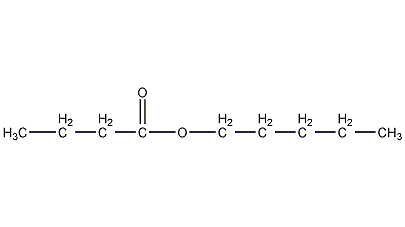
Structural formula
| Business number | 05K2 |
|---|---|
| Molecular formula | C9H18O2 |
| Molecular weight | 158.24 |
| label |
n-amyl butyrate, n-Amyl n-butyrate, Pent(alk)ylbutyrate, Pentyl butyrate, 1-Pentyl butyrate, CH3CH2CH2COO(CH2)4CH3, Spices raw materials |
Numbering system
CAS number:540-18-1
MDL number:MFCD00053739
EINECS number:208-739-2
RTECS number:ET5956000
BRN number:None
PubChem ID:None
Physical property data
1. Properties: colorless liquid with bitter almond smell. [1]
2. Melting point (℃): -73.2[2]
3. Boiling point (℃): 185[3]
4. Relative density (water = 1): 0.87[4]
5. Relative vapor Density (air=1): 5.46[5]
6. Octanol/water partition coefficient: 3.320[6]
7. Flash point (℃): 57[7]
8. Ignition temperature (℃): 582[8]
9. Solubility: insoluble in water, miscible in ethanol and ether. [9]
10. Relative density (25℃, 4℃): 0.8617
11. Refractive index at room temperature (n25): 1.4104
Toxicological data
1. Acute toxicity:
Oral LD50 in rats: 12210 mg/kg, behavior – lethargy (common depressive activity), affecting skin and accessories – hair;
Guinea pigs Oral LD50: 11950 mg/kg, behavior – lethargy (common depressive activity), ataxia.
2. Acute toxicity [10] LD50: 12210mg/kg (rat oral)
3 .Irritation No information available
Ecological data
1. Ecotoxicity No data available
2. Biodegradability No data available
3 .Non-biodegradability No data yet
4. Other harmful effects[11] This substance is harmful to the environment and harmful to water bodies Special attention should be paid.
Molecular structure data
1. Molar refractive index: 45.51
2. Molar volume (cm3/mol): 180.5
3. Isotonic specific volume (90.2K ): 414.9
4. Surface tension (dyne/cm): 27.8
5. Polarizability (10-24cm3): 18.04
Compute chemical data
1. Reference value for hydrophobic parameter calculation (XlogP): 2.7
2. Number of hydrogen bond donors: 0
3. Number of hydrogen bond acceptors: 2
4. Number of rotatable chemical bonds: 7
5. Number of tautomers: none
6. Topological molecule polar surface area 26.3
7. Number of heavy atoms: 11
8. Surface charge: 0
9. Complexity: 99.7
10. Number of isotope atoms: 0
11. Determine the number of atomic stereocenters: 0
12. Uncertain.Number of stereocenters of chemical bonds: 0
13. Determine the number of stereocenters of chemical bonds: 0
14. Uncertain number of stereocenters of chemical bonds: 0
15. Number of covalent bond units: 1
Properties and stability
1. Stability[12] Stable
2. Incompatible substances[13] Strong oxidants, strong acids, strong alkali
3. Polymerization hazard[14] No polymerization
Storage method
Storage Precautions[15] Stored in a cool, ventilated warehouse. The storage temperature should not exceed 37°C. Keep away from fire and heat sources. Keep container tightly sealed. They should be stored separately from oxidants, acids, and alkalis, and avoid mixed storage. Use explosion-proof lighting and ventilation facilities. It is prohibited to use mechanical equipment and tools that are prone to sparks. The storage area should be equipped with emergency release equipment and suitable containment materials.
Synthesis method
It is produced by esterification reaction using n-butyric acid and n-amyl alcohol as raw materials and zinc chloride as catalyst.
Purpose
1. Mainly used as spices in the food industry to make candies, cakes, etc.; it is also an excellent anti-corrosion agent, organic solvent and general reagent.
2. Used in organic synthesis. [16]

 微信扫一扫打赏
微信扫一扫打赏

